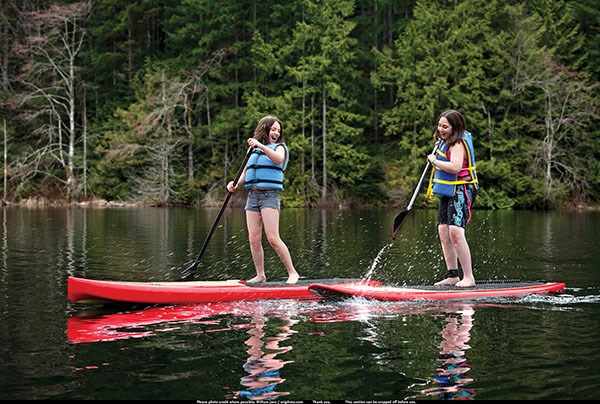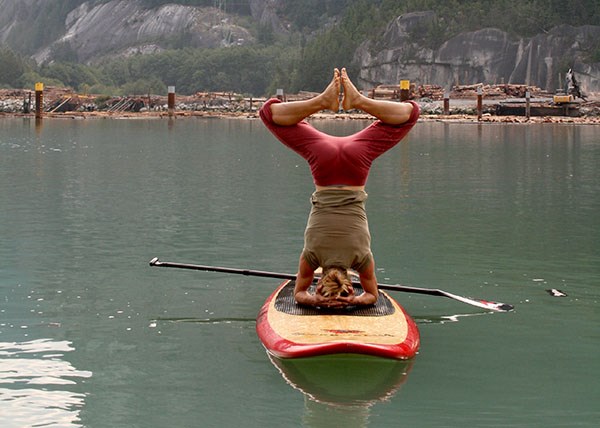It’s an interesting sensation the first time you find yourself standing out on the calm, glassy waters of Howe Sound a few metres off the shores of Nexen Beach.
It’s a novel perspective to be upright, knees bent, feet spread wide apart just an inch or so from the still ocean on a stand up paddleboard (SUP). It offers a different way to relate to the scenery than when seated in a canoe or kayak, and unlike sports such as kiteboarding, you don’t need the help of wind.
“It’s the closest thing to surfing in this area,” said Taylor McKechnie, a Squamish local who, along with fellow paddlers Jay Butler and Diana Frederickson, is going out on on a SUP tour from Nexen to Britannia Beach.
You have to get out early, even before the sun peaks out from behind the Stawamus Chief, if you want calm waters on the ocean, though.
The three have tried the sport before, and are now here at 7:30 a.m. trying to make up their minds about SUP.
“The goal is to see if it’s worth buying one,” said McKechnie.
While they start their journey down Howe Sound with Ico Schutte, a guide from Sea to Sky Adventure Company, Jessica (Jessi) Stensland, the company’s director of adventure, stays behind to chat about the growing popularity of SUP.
“It’s a great sport that’s easily accessible,” she said. “Almost anyone can get on a board and experience SUP. And people these days, especially in a place like Squamish, are always wanting to try new things.”
But SUP is anything but a new sport.
The history of stand up paddling is hard to confirm. There’s evidence that for 3,000 years Peruvian fishermen have used a small woven reed craft propelled with a long bamboo shaft shaped like a kayak paddle. In fact, many ancient cultures from Africa to South America used boards, canoes, and other watercraft moved with a long stick to fish, travel or make war.
But it’s generally accepted that the first stand up paddlers to hop on a board for the sheer joy of it were Hawaiian. Though Hawaiians have probably been stand up paddling for centuries, the earliest photographic evidence is only about 75 years old. Duke Kahanamoku, an Olympic swimmer and the man responsible for popularizing surfing off-island, was said to use an outrigger paddle to help propel his heavy board into Waikiki’s world-famous waves. In the 1940s, Kahanamoku and other Waikiki Beach Boys (instructors) like Leroy and Bobby AhChoy would take paddles and stand on their surfboards to get a better view of the other surfers in the water and incoming swells. They would also paddle out to take pictures of the tourists learning to surf, which is where the term “Beach Boy Surfing” originates, also known as stand up paddle surfing.
“Yeah, I’ve heard the stories that Duke Kahanamoku was one of the people responsible for starting SUP,” said Stensland.

Stand up paddling didn’t really come into vogue until the early 2000s, though, when Hawaiian surfers such as Dave Kalama, Brian Keaulana, Rick Thomas, Archie Kalepa and Laird Hamilton started SUP as an alternative way to train while the surf was down. It wasn’t long before SUP spread across the ocean to the mainland.
“I first got into SUP after moving to San Diego, Calif., which was one of the first places to adopt SUP,” said Stensland, who is originally from New Jersey. “I was a professional triathlete, and someone gave me a board and I took it out on the ocean.”
She then move to Colorado, but continued to enjoy SUP.
“There was no ocean in Colorado, so we went out on reservoirs and lakes,” she said. “That’s another one of the great things about SUP. You can do it anywhere there’s water… rivers, lakes, the ocean.”
It’s also great and low impact exercise for your core muscles.
“I’m a movement expert,” Stensland said. “I have a degree in exercise science. I find today, we spend so much of our time sitting – at our computers, in our cars, in front of the TV – and SUP gives us the ability to use our bodies from a fully standing position. It also works your arms with that vertical pulling motion.”
She said the sport offers full hip extension, and gives your feet a good workout.
“Our feet are often stuck in shoes,” she said. “And feet are a big player in SUP.”
“We often get the comment that people didn’t know SUP was such a workout on their feet,” said Jeff Levine, who originally started Sea to Sky Adventure Company in 2010 as a bike rental business in the Squamish Adventure Centre.
That same year, they added SUP rentals to the mix.
“We started renting out stand up paddleboards, but they kept coming back dinged up and in bad shape,” Levine said. “We thought the construction of the boards wasn’t all that durable. Those boards were designed by surf companies in nice tropical areas. So, they were made for use on nice sandy beaches and in nice warm water.”
The Brackendale resident said he was faced with what he started calling “the Canadian challenge.”
“Here in Canada, we have rocky shores and cold water,” Levine said. “We needed to have boards that could stand up to our somewhat harsher conditions.”
Finding nothing around to suit the rental company’s needs, he had special boards designed just for Canadian conditions.
“We went with old school fiberglass surrounded by a bamboo layer,” he said. “That makes them easier to fix, and
more stable.”
The people renting these new boards liked them so much, Levine was inundated with requests to purchase the specially made items. Eventually, he relented and helped found Beaver Boards, a family business based in Brackendale that designs stand up paddleboards for both adults and kids.
“We now sell our Beaver Boards all across the country through Canadian Tire,” he said. “And we’re expanding our markets now to places like Mexico.”
All the boards – like the Sea to Sky Cruiser – made specifically for paddling in Howe Sound, are designed in Squamish, but manufactured in China.
That’s something Levine wants to change.
“As we are expanding our markets and growing our numbers, we want to eventually move the manufacturing to Squamish,” he said. “Since about 2005 the sport has been increasing in popularity. It used to just be the fastest growing watersport in the world, but now it is the fastest growing sport in the world. It’s because anyone can do it. I suffered neck and back injuries and couldn’t sit in a canoe or kayak anymore. I still wanted to do something on the water, and SUP let’s you do that, and it’s a phenomenal workout.”
“It’s also the serenity of being out there,” said Stensland. “And it’s a very versatile sport. People are finding new ways to use the boards, like for yoga.”
“It’s walking on water,” said Levine.
So despite murky origins in the distant past, SUP looks to have a promising future, especially in Squamish.



